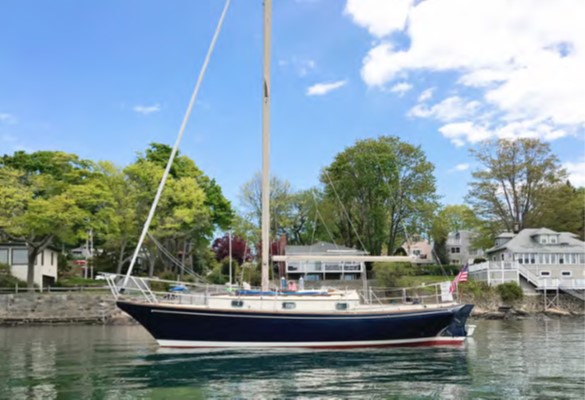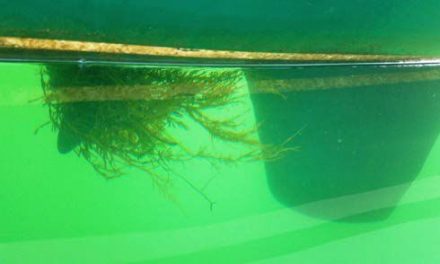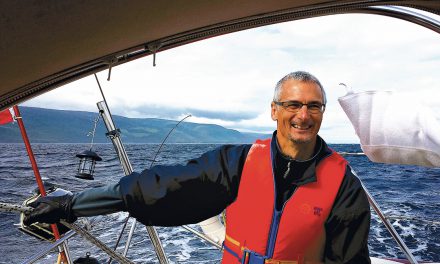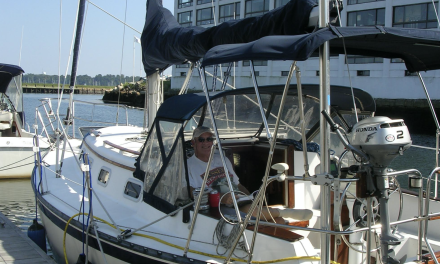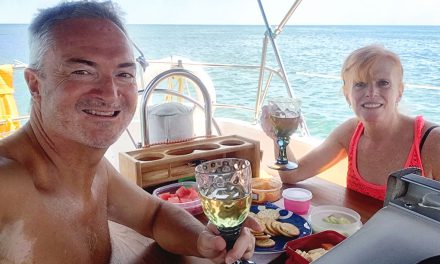Often it’s the little things that make a boat feel like home.
Issue 141: Nov/Dec 2021
A small sailing craft is not only beautiful…if it happens to be an auxiliary cruising boat, it is without question the most compact and ingenious arrangement for living ever devised by the restless mind of man—a home that is stable without being stationary, shaped less like a box than like a fish or a bird or a girl, and in which the homeowner can remove his daily affairs as far from shore as he has the nerve to take them, close-hauled or running free—parlor, bedroom, and bath, suspended and alive. —E.B. White
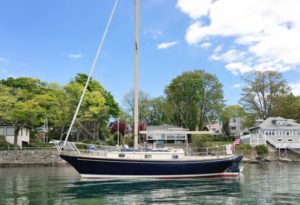
Elsa Marie, David’s 1979 Independence 31.
And in that floating small home, comfort is, of course, important. But comfort is more than a soft pillow or a hot shower. Comfort is also a state of mind. It’s about feelings of satisfaction, contentment, and well-being. These can come from items or colors or even smells that are evocative, conjuring up good memories that bring comfort. In my case, sometimes this goes to extremes: I remember, several boats ago, putting a ball of tarred hemp under my bunk because the scent reminded me of the old manila rope on my dad’s wooden cutter built 80 years ago.
In the Metropolitan Museum of Art in New York City hangs a small etching titled “The Cabin,” created by Anders Zorn in 1917. A framed copy of it also hangs on the main cabin bulkhead, alongside the big brass paraffin lamp, aboard my 42-year-old Independence 31, Elsa Marie. It’s an evocative work of a sailboat cabin of the early 1900s. My father framed it and put it on the bulkhead of our old Atkin cutter, Phyllis, about 60 years ago.
Years later, my dad transferred it to the bulkhead of his next boat, Eastward, where it traveled along some 35,000 miles over the next decade. When he sold Eastward, he gave the etching to me.
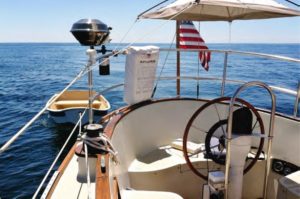
David’s Magma grill, on which he can cook virtually anything, including popcorn, and the homemade shade for the helmsman or book reader, are two comfort items in Elsa Marie’s cockpit.
I placed it on the bulkhead of Chang Ho, my Cape Dory 25, where it hung for a decade. It now hangs on Elsa Marie’s bulkhead, where its very presence brings me comfort because of the times, places, and memories it evokes—family stories of my childhood aboard Phyllis and Eastward; budding relationships as a teen; confiding conversations as adults; laughter and romance under the cabin lamps in each of those four boats over six decades. In short, it has meaning, and that meaning brings comfort. All this from an 8 x 10-inch etching! More folks should plant personal memorabilia in their boat cabins, that small living space which, due to its size, requires an intensity of comforting visuals.
Elsa Marie’s cabin has four bunks that we’ve covered in what my wife, Mary Kay, calls “lake cottage green” canvas. This fabric and its color bring comfort to the cabin and to my wife, who feels a strong sense of place from the Minnesota lake cabin where she grew up, where the walls and old stuffed chairs (and sometimes even the lake) were the same shade of green.
Green is a color that represents the environment and outdoors, for obvious reasons, making it a clear choice to suggest nature and an organic quality, all a good fit on a boat. And, artists, therapists, and interior designers have long understood how the right color can dramatically and positively affect moods, feelings, and emotions. In a sense, my wife’s lake cabin was her version of my childhood boat, the Atkin cutter Phyllis. So, it was an easy decision to bring a representation of these comforting memories aboard Elsa Marie when we chose the upholstery.
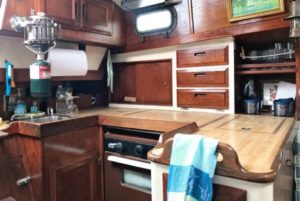
The gimballed Forespar burner mounted next to the companionway is one of David’s favorite cooking devices onboard—despite the three-burner galley stove.
Elsa Marie’s cabin is a reflection of my floating world as a child, young adult, and older man. But it’s also a reflection of what I’ve learned about living comfortably in a small space—about the value and joy of minimalism. For me, there’s immense satisfaction in making a small cabin uncomplicated and a manifestation of oneself, equipped with only what’s truly needed, and all within easy reach.
How satisfying to sit on your bunk and plan the best location for new essential things—for a coat hook in just the right spot, or a mount for your handheld GPS within easy reach or viewing, or even a paper towel rack positioned in such a way that the wind doesn’t blow down the hatch and unroll it. After all, it’s your little world, it’s your creation. All the little tweaks are yours, and you’re proud of where you placed those essentials and accoutrements.
On the old Phyllis, my dad slept on a hanging, spring-bottomed “destroyer” berth from WWII that put his nose just a foot below the cabin overhead. When cruising, he strung shock chord across the beams above him and slid the next day’s charts under it, so in the morning his eyes opened to the buoys, depths, islands, and harbors of that day’s run. It gave him information, heightened his anticipation, and just made him happy to imagine what was coming.
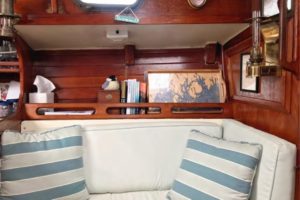
The fabric colors aboard Elsa Marie were selected to mirror a shade of green that reminds David’s wife of her childhood time spent in a Minnesota lakeside cabin.
And then there are the simple, reliable things that are clever and provide us with an innate sense of satisfaction. I think of the two bricks my dad kept under the old alcohol stove aboard Phyllis. Along with the paraffin lamps, they were the cabin dryers.
On foggy or rainy days in Maine, Dad would carefully fire up the old, pressurized alcohol stove and place a brick on each burner, “cooking” them until well done. Then he would turn off the stove, leaving the bricks on the burner, and he and my mother would close the cabin portholes and hatches and row ashore for a walk. Upon return, they would enter a cozy, comfortable space, the bricks having done their job of drying and warming the cabin.
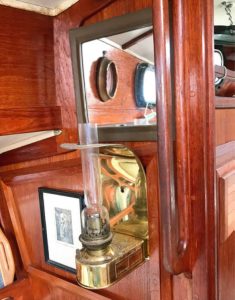
Whether it’s an oil lamp, artwork, or a strategically placed mirror, David believes in the power of carefully chosen items to warm up an otherwise austere environment.
In Elsa Marie, we keep our cooking simple, as well. Despite the three-burner gimballed stove on board, all we ever seem to need is the Magma grill/cooker that hangs off the stern (I’ve cooked lobsters, steaks, English muffins, zucchini, popcorn, and even pancakes on that grill), and a little Forespar gem that’s conveniently mounted just inside the companionway. That one is the real joy. It’s stainless, gimballed, and comes with a mini fry pan, stew pot, kettle for tea, and even a coffee percolator. This and the Magma run on the same small green propane bottles. The on- and off-watch have easy access to the Forespar for tea or soup. Especially during inclement weather or at night, this is a real plus. Both cookers are simple and easy to maintain.
Rituals on a small boat also become important to comfort. Little actions become more valued. The small world of the cabin is cared for more, like the world of a small town. Everything seems to matter more; everything seems more intimate. You get off a bus onto 5th Avenue in New York City and appear temporarily lost and nobody notices, nobody makes eye contact, nobody seems to care. Everything is just too big, and the people are too many.
But when you walk into a tiny town and stop and look to get your bearings, someone is likely to ask, “May I help you? You seem lost.” You matter more, it seems. For many of us, there’s no place more soothing than the cabin of a sailboat.
We love our boats. We think about them a lot (sometimes too much). We plan for ways to make things even better, even more comfortable. And that makes us happy. And I know we all agree on that, for, as Mark Twain said, “A man cannot be comfortable without his own approval.”
David Roper is the author of three nautically themed books, among them the three-time Boston Globe bestseller Watching for Mermaids. A columnist for Points East magazine, he’s also written for Cruising World, Lakeland Boating, SAIL, and Sailing. Among his youthful occupations was captaining a 135-foot Mississippi River paddlewheel cruise ship. Presently, he sails his Bruce King-designed Independence 31, Elsa Marie out of Marblehead, Massachusetts.
Thank you to Sailrite Enterprises, Inc., for providing free access to back issues of Good Old Boat through intellectual property rights. Sailrite.com

